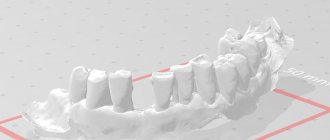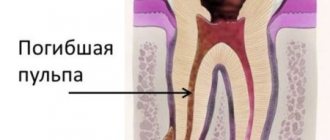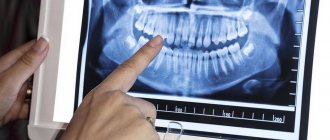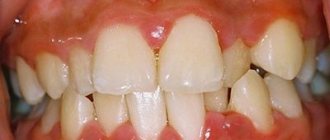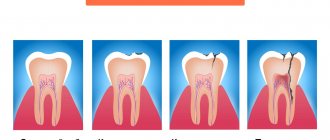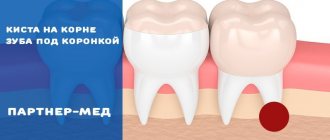First of all, we note that the price for treating pulpitis of a three-canal tooth really depends on the number of these very root canals in it, and here the general rule is this: the more there are, the more expensive the treatment procedure usually costs. And not only more expensive, but, in addition, with a large number of roots, a number of nuances of endodontic procedures often arise, which we will talk about in more detail later.
On a note
Pulpitis is a disease in which inflammation of the so-called dental “nerve” (pulp) occurs. Large molars (molars) most often have three canals, each of which contains a neurovascular bundle. When an inflammatory process occurs in the pulp, it swells and is compressed, as a result of which a person can feel severe pain.
Pulpitis requires mandatory treatment: you should not expect that everything will somehow resolve and the pain will go away on its own, as sometimes happens in the case of pain during caries. The pain may indeed disappear when the “nerve” completely dies, but then it will begin to decompose right inside the tooth, and without appropriate treatment this will not lead to anything good.
Treatment of pulpitis of a three-canal tooth, in contrast to a single-canal one, is often technically more difficult, so in order to carry out high-quality work, the doctor has to spend more effort and time, and also actively apply the achievements of modern dentistry.
Today, in most clinics, three-channel pulpitis is almost always treated by extirpation - removing the nerve from all canals and filling them at the final stage of intracanal treatment.
This is interesting
In the upper wisdom teeth there are the most unpredictable variations in the number and location of roots and canals. As a rule, doctors are faced with one-, two- and three-canal eighth teeth, but there have also been cases of 4 and even 5-root teeth with up to 8 full canals!
Three-channel pulpitis in most dental clinics is treated in two visits. For these purposes, the so-called vital extirpation technique is well suited, when, under local anesthesia, the pulp is removed from all three canals and they are filled, followed by the placement of temporary filling material on the tooth. And on the second visit, the permanent filling is successfully installed.
Let's now see how this happens in practice.
First visit:
- tooth pain relief;
- preparation of carious softened tissues with a turbine tip, removal of necrotic and pigmented dentin;
- washing with antiseptics;
- opening good access to the mouths of three canals;
- expansion of mouths;
- rubber dam application;
- extirpation (extraction) of pulp from all three canals using pulp extractors;
- passing the canals with files, measuring their length, expanding with K-files, H-files, machine instruments with constant irrigation (washing) of the canal system with sodium hypochlorite solution;
- the use of EDTA preparations for poorly traversed canals;
- drying of canals, control measurement of their lengths;
- filling the canals using the method of cold lateral condensation of gutta-percha pins with paste or using the Termafil system for obturation;
- placement of a temporary filling or temporary restoration of a tooth;
- control image (x-ray).
Second visit:
- reprocessing of the tooth;
- placement of a permanent filling made from a light-curing composite or other imported material (an example is shown in the photo below).
Sometimes pulpitis of a three-rooted tooth is treated in three visits or even more. This depends on the chosen technique, the doctor’s tactics, the level of his professional skills and sometimes on the difficulties that arise during intracanal treatment.
If it is impossible to immediately remove the pulp from the canals, the dentist places a devitalizing drug on the opened pulp chamber in order to “kill the nerve” for the next appointment. Accordingly, this increases the treatment of three-channel pulpitis by one visit.
In Soviet times, even single-channel pulpitis was treated with “arsenic” for a period of 24 hours. This practice is no longer acceptable at the current level of development of dentistry. Treatment of pulpitis of a single-canal tooth, as well as a double-canal one, is almost always carried out in one visit (with rare exceptions).
Large molars (mainly the lower ones), due to the structural features of the jaw and the location of the nerves that determine the sensitivity of the tooth, sometimes may not be “frozen” to such an extent that the nerve can be removed immediately, that is, pain sensitivity remains. Therefore, the way out of this situation is the preliminary use of pulp-killing pastes (popularly they are still called “arsenic,” although modern preparations have not contained arsenic for a long time).
It is also useful to read: Symptoms of pulpitis: what is important to know in case of severe tooth pain
On a note
In a number of clinics, treatment of pulpitis is always carried out in one visit, regardless of the number of canals: they are filled, and a permanent filling is immediately installed on the tooth. Studies have shown that this practice often leads to long-term negative consequences, since the material introduced into the canals must first harden. In construction, work does not begin until the foundation hardens, as the consequences can be disastrous - and the situation is the same here. That is why it is recommended to treat pulpitis in at least two visits.
What is three-channel pulpitis?
The number of canals in each tooth varies, usually one or two, in molars – most often three. There are record-breaking patients in whom up to eight processes were discovered during treatment. Three-channel pulpitis, as the name implies, is diagnosed in a tooth that has three channels. Inflammation of the pulp or, as is often said, the dental nerve, manifests itself in severe pain. It can be paroxysmal, worse at night, radiating to the ear or temple. It is impossible and dangerous to endure such acute pain for a long time. According to experts, pulpitis is the reason every fifth patient visits the clinic.
Causes of the disease
Pulpitis is an inflammatory process that affects the soft tissues and neurovascular plexuses that fill the tooth cavity.
A characteristic symptom of the disease is acute pain, which intensifies with sudden changes in temperature, and is also disturbing at night. The main causes of the disease are progressive caries or its poor treatment. Carious cavities formed on the surface of tooth enamel become entry points for pathogenic infections, the waste products of which lead to the development of pulpitis.
Most pulpitis is caused by the following microorganisms:
- streptococci;
- staphylococci;
- lactobacilli, etc.
Another common cause of pulpitis is tooth trauma, accompanied by damage to the crown with the formation of cracks, chips, etc. It is extremely rare that the disease occurs under the influence of aggressive chemical and temperature factors.
Specifics of treatment of three-channel pulpitis
Treatment of pulpitis of a 3-canal tooth is considered complex and must be carried out with special care. In severe cases, several visits to the dentist are required.
- The doctor spends an hour to an hour and a half on a multi-channel tooth;
- under a microscope - about two hours.
This is due to the fact that 3-channel pulpitis requires treatment in each process.
Treatment under a microscope
Treatment of three-channel pulpitis is carried out by a specialist in the field of endodontics. Work in the dental canals is best done under a dental microscope. This method has many advantages.
Advantages of treatment under magnification
- The dental canals are very thin, tortuous, no more than 1 mm in diameter. The microscope magnifies them to 2.5-3 cm. The dentist does not treat blindly, under magnification he clearly sees all the branches and foci of inflammation. Treatment of pulpitis of the 3rd canal takes place in good lighting.
- The patient lies down, the doctor looks not into the mouth, but into the microscope camera. This has a calming effect on dentophobes.
- The microscope reveals the most difficult to reach areas for the doctor. This is especially true for patients who have hidden dental canals that are not visible to the human eye. And during endodontic treatment, it is important to remove all foci of inflammation to avoid relapse.
Reviews
Kamila
Very good place and professional doctors. Respectful, attentive attitude towards patients. They are able to treat very well, even complex cases. Many thanks for your professionalism, patience and high personal qualities.Igor
Not long ago I came to treat three-channel pulpitis. From experience in other dentistry, I know that anything can happen. I was very worried about how everything would happen this time. I want to say that the treatment went just fine. I fully felt the professionalism of the doctors. I am very pleased with my visit to this dentistry!
Stages of treatment for 3-channel pulpitis
Treatment of pulpitis of one- and two-canal teeth, as a rule, occurs in one appointment. Three channels are put in order in two visits. Some clinics offer to treat pulpitis of the 3rd canal tooth in one go. There is no need to take risks, it is better to do everything according to the rules.
To treat three-channel pulpitis, the vital extirpation method is used. The pulp is removed, the canals are thoroughly cleaned, disinfected and sealed. Let's look at each stage of treatment of root pulpitis 3 in detail.
Stages of treating pulpitis without a microscope
- Pain relief using local anesthesia.
- Removing softened tissue and washing the cavity with an antiseptic.
- Expansion of the mouths of three canals and removal of pulp.
- Flushing the canals with sodium hypochlorite as an antimicrobial treatment.
- Drying and filling the canals and installing a temporary filling on the crown of the tooth.
- Evaluation of treatment results using control x-rays.
The main treatment takes place during the first appointment. A break is needed so that the filling material in the canals hardens well. The second stage will take less time: the tooth will be processed again and a permanent filling will be placed.
The number of appointments may increase to three if it is impossible to immediately remove the pulp from the canals. In this case, the nerve will be “killed” by a special paste. It will be added to the cavity and left until the next visit. Soviet patients said this: “They put arsenic.” This substance is not used in modern toothpastes, but many, out of habit, believe that the dental nerve is removed with the help of arsenic.
Why do they trust us?
Our dentistry uses modern scientific methods in dental treatment. Over 16 years of impeccable work, we have helped more than 20,000 patients to promptly cure oral diseases, maintain healthy gums and a beautiful smile.
We have our own diagnostic room with modern digital equipment and a dental laboratory. You will receive all the necessary examinations, treatment and prosthetics in one place.
The clinic employs successful specialists with highly professional experience in dentistry. Doctors annually take special courses, improve their qualifications, and participate in international symposiums.
We see the following specialists:
- dentist-therapist;
- orthopedic dentist;
- orthodontist;
- dental surgeon;
- periodontist;
- pediatric dentist;
- Dental Technician;
- radiologist.
Can three-channel pulpitis go away on its own?
Pulpitis of a three-canal tooth, of course, will not go away from lack of treatment and will become chronic. The nerve will die under the influence of microbes, the pain will go away, and the patient will deceptively think that the problem is solved. But this will turn out to be a temporary calm before the storm. The nerve will decompose inside the tooth, there will be even more microbes, inflammation will affect the surrounding tissues, and ultimately it will all end in the formation of a cyst. It will be very difficult to save such a tooth from removal. Treatment of pulpitis of a 3-canal tooth should be immediate.
Treatment of a single-canal tooth
Root canal treatment for single-canal teeth involves cleaning the part where the nerve tissue was previously located. The purpose of this treatment is to eliminate bacteria accumulated in the inside of the tooth, remove all organic waste that is a breeding ground for bacteria and fill the vacated space, which completely stops their vital activity.
Single-channel teeth include incisors and canines. The exact number of channels is confirmed using a snapshot. The advantage of such teeth is that their canals are rarely branched or curved, which simplifies the treatment process and reduces the risk of possible complications.
How much will treatment cost in Moscow clinics?
Treatment of pulpitis of a three-channel tooth will cost the patient a lot. The price in Moscow dentistry starts from 5,000 (without a filling on the crown) - 7,000 rubles (with the simplest filling) and reaches 13,000 rubles. Treatment under a microscope increases the cost of 3-channel pulpitis to 21,000 rubles. The prices for treatment of pulpitis are influenced by the quality of the instruments used by the doctor, the choice of anesthesia, means for disinfecting the canals, as well as the material from which the filling is made. All this needs to be taken into account before going to the doctor.
Diagnostics
Advanced pulpitis can cause serious complications and loss of a diseased tooth, so if you experience any symptoms, you should make an appointment with a dentist as soon as possible. The pathology is diagnosed based on the patient’s complaints, examination by a dentist and the results of an instrumental examination.
During a dental examination, the doctor discovers carious cavities with softened dentin. The diseased tooth reacts sharply to temperature changes, percussion is painful.
To clarify the nature and depth of spread of pulpitis, the following diagnostic methods are additionally prescribed:
- radiography;
- electroodontic diagnostics;
- CT scan.
Performing pain relief
It is impossible to treat pulpitis without anesthesia. Therefore, the doctor will certainly perform a blockade of nerve endings to make the patient feel better and the doctor to work more conveniently. The lower chewing teeth in the back of the mouth are the most difficult to respond to painkillers. Here the dentist will have to show the art of administering mandibular anesthesia. In most cases, some of the painful sensations will remain during the treatment of distant teeth; this is determined by the anatomy of the nerves located in these teeth.
Canal treatment using a microscope
The diameter of the root canal of a tooth is approximately 1 millimeter. In such conditions it is impossible to work with it without special optics. The dental microscope allows you to increase visibility up to 32 times. Therefore, it is increasingly used in modern dentistry.
Advantages of using a dental microscope:
- The specialist can see and remove only tissues affected by inflammation, without touching healthy ones.
- An excellent overview of the tubule orifices is achieved. Seeing the number of their branches, depth and directions is very important during endodontic treatment.
- Due to targeted treatment of the pulp, complications can be avoided. The possibility of perforations is also eliminated.
Measuring the length of root canals
The most important stage in the treatment of pulpitis is the correct determination of the length of the tooth tubules. In an ideal situation, the canal is filled to the apex - the physiological narrowing of the apex. If the doctor incorrectly assessed the length and underfilled or overfilled the canal, in both cases unpleasant consequences are likely: inflammation, pain, damage to the mandibular nerve, the appearance of cystic formations, etc.
Measuring the length of the canal is carried out using a combination of two methods: checking with an “apex locator” and x-ray examination.
In the first case, a specialized K-file instrument is placed in each root canal, connected to an “apex locator” with an electrode. When you touch the root tip, the device emits a signal.
The length of the canals varies greatly from person to person, so there are no standard sizes. When the individual canal measurements are completed, the doctor places K-files in all holes and sends the patient for an x-ray. In the image, the doctor will see exactly whether an error has crept into the device readings, how large it is, and whether adjustments need to be made.
Mechanical processing of channels
It is performed with special devices: K-files, cone-shaped with spiral-shaped cutting edges. By turning the instrument inside the canal, the doctor expands the walls for the subsequent introduction of obturation material.
The world's leading dentists adhere to the position: it is not so important how the canal is filled, what is much more important is how well it is prepared. During the preparation process, it will be necessary to expand the channel cavity to a certain depth, which will result in the formation of chips. In addition, the canal is washed to remove living and dead bacterial biomass, pulp residues, etc.

